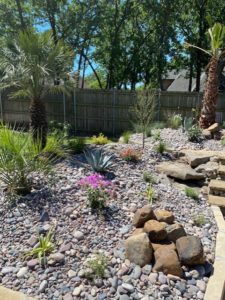
Do you want to create an eco-friendly and sustainable landscape design for your property? Well, who doesn’t? Being sustainable might feel complicated, but you can have the ideal sustainable landscape design with simple and small steps and changes. Along with that, sustainable landscape design is not only good for the environment but also benefits you financially. But before we delve into the details of this kind of landscape design, let us look at what sustainable landscaping is all about.
What Is Sustainable Landscaping?
The approach to sustainable landscaping and landscape design is quite simple. It uses numerous styles and techniques to develop a functional, luscious, thriving landscape that doesn’t harm nature.
But you must be wondering, aren’t all landscapes eco-friendly? Not really. There are a lot of things that separate a sustainable landscape design from a non-sustainable one. Here are just some of the few separating factors:
- Fertilizers: Average non-sustainable landscape design relies heavily on fertilizers and pesticides, whereas sustainable design requires little external help.
- Water: A sustainable landscape design is built for water conservation, whereas the alternative requires huge amounts of watering to survive.
- Wildlife and Habitat: With local and sustainable landscaping, they support native habitats, whereas the other rarely does so.
- Maintenance: Non-sustainable option is generally quite high maintenance and requires regular care, whereas the other option can survive without it.
Work With Native Plants
When working with sustainable landscape design, native plants are the best choice as they have adapted and evolved to endure the environmental condition of the area without regular human involvement. Native plants do not need support such as chemical fertilizers, pesticides and more as they occur naturally in the area. Non-native plant, on the other hand, relies heavily on human assistance and consume a considerable amount of resources.
Since native plants require fewer fertilizers, your soil and fertility conditions are bound to improve. Native plants are also home to local birds, bees and other animals, which improves the area’s ecosystem and preserves biodiversity. Native plants also reduce financial strain because they do not require elaborate care, irrigation and fertilizers.
Lean Towards Permeable Hardscapes
If you have a lawn, you know they are not sustainable due to how much water they consume for maintenance. It is mainly because most lawn tuft grasses are non-native, requiring external support to survive. If you want to be green and eco-friendly, consider downsizing your lawn and investing in hardscapes.
But which hardscapes should you work with to get the best results? Permeable hardscape is one of the best choices when it comes to hardscapes. Here are some of the reasons why:
- Reduced runoff compared to impervious surfaces.
- Better water absorption into the soil
- Cooler surface temperature
River rock, porous asphalt, decomposed granite, and pea gravel are great options for permeable hardscapes.
Use The Sun To Your Advantage
Solar-powered landscape lighting is an excellent option if you want to conserve energy and use renewable resources to brighten your landscape. If you place them in the right spots, you can accentuate how your landscape design appears at night. When you use solar lighting, sun rays throughout the day are converted into electricity at night and saved you money on your overall energy bill.
Harvest Your Rainwater
Another method to ensure you have a more sustainable landscape design is to set up a rainwater harvesting station. You can do this by investing in a rain barrel that complements your the architecture and aesthetic of your overall landscape design. You can even disguise the barrel station with stone, plants, and bushes.
The collected rainwater can be used to water your plants, lawn and more, allowing you to conserve water and save money on your water bill.
Embrace The Wildlife
Enhance biodiversity by incorporating a wildlife garden in your landscape design. A wildlife garden is a great opportunity for you to give back to nature. It provides food, shelter, and food to the local birds, bees, butteries and other furry little creatures. With the proper planning, you can also get free pest control with these wildlife gardens.
Here are some options for wildlife gardens that you can place in your landscape design:
- Bird feeders
- Butterly garden
- Meadow garden
- Water garden
- Wildflower garden
- Bog garden
Where to Find The Best Landscaping Company in DFW?
Are you looking for the best landscaping company in DFW to work on your sustainable landscape design? Landscape Innovations is the answer! We specialize in creating the best landscape designs for your property. With decades of experience, we have come a long way to understand your needs and recreate your envisioned landscape.

